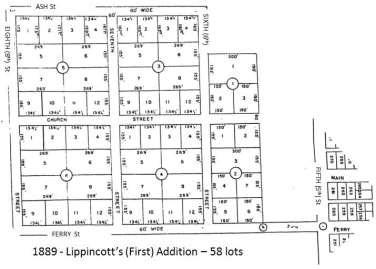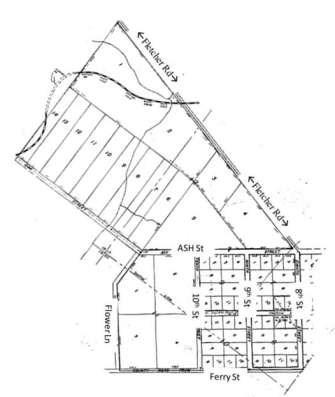
4 minute read
Historical Highlight -
Lippincott Gulch? Lippincott’s Additions? Who was Lippincott?
When you look at maps for Dayton, you’ll find “Lippincott’s Addition” and “Lippincott’s Second Addition.” Plus, there is “Lippincott Gulch” that passes under Ferry St by 5th St and goes on down the hill behind City Hall. This all got me to wondering about Lippincott, and why is their name on the map of Dayton?
The 1879 Yamhill County Map shows Lippincott’s property extending from 5th St out of town. The original town of Dayton city limit stopped at 5th St. Long ago, a wooden bridge spanned the gulch on Ferry St. The 1880 law that incorporated Dayton, and declared its boundaries, references Lippincott Gulch. So who was Lippincott?
Jackson Lippincott lived in Laurel, Indiana in 1840s – the same town where Joel Palmer lived. Jackson had a mercantile business. He married Harriet Williams in 1846; had son Benjamin in 1847; and JL went to California for gold in 1849, by himself. He made a small fortune; returned home and moved his family to Oregon in 1853.
They were motivated to settle in Dayton because Harriet’s sister, Sarah lived here with her husband Chris Taylor – a well known figure in Dayton history. Taylor was a close associate of Joel Palmer’s. Taylor came to Oregon with Palmer on the wagon train in 1847. Taylor married Sarah Williams, here in Oregon, in 1850. Harriet and Sarah’s brother Thomas K Williams lived in Dayton too.
Mr. Lippincott, with his brother in law, Thomas K. Williams, purchased the merchandise stock of their brother- in-law, Chris Taylor, and engaged in the mercantile business as Williams & Lippincott. They sold food and goods. The store was located around 2nd and Ferry St. In Joel Palmer’s diary of 1860, he remarks of bills he paid to Williams & Lippincott. They also served as agents of Fort Yamhill and Fort Hoskins and through them all Government supplies were transmitted. During this time, Jackson Lippincott acquired real estate in this area, too.
Life changes came about like they do for us all. In 1860, Jackson’s wife Harriet passed away – buried in Brookside Cemetery. In 1865, Thomas K Williams went visiting to Indiana; got sick and died there in 1866. In 1867, Jackson Lippincott died leaving his son Benjamin as sole heir. Chris Taylor was appointed executor of Jackson’s estate valued at what would be today, around $425,000. William S Ladd, from Portland was appointed Benjamin’s guardian and he sent him to finish his schooling at Willamette University.
After his dad passed, Benjamin visited family in Laurel, Indiana, and on this trip, married Frank L. Manley. Frank was a ‘Frances,’ but called herself Frank. By 1870, BE had gone into the mercantile business with his uncle Chris Taylor. He also worked for Joel Palmer as a clerk in the Siletz Indian Reservation. He and Frank then moved to Portland where he was Chief Deputy Customs House Inspector and later started a real-estate and custom house brokerage business.
Frank was a business partner with BE. And this brings us to 1889 Lippincott’s Addition was mapped out in 1889. This added 58 large lots to Dayton extending and creating streets and lots from 5th St to 8th St, from Ferry St to Ash St..

In Oct 1890, Lippincott’s Second Addition was mapped, adding 66 large lots to Dayton area, extending from 8th St to Flower Lane, from Ferry to Ash St, and out Fletcher Rd.

Overtime things change – people built their own homes on lots; some lots were subdivided; others bought and developed for high school. Highway 18 runs through a portion of the area past Ash St
So, who was Lippincott? Jackson Lippincott came to Oregon with his family to build a home, a family, a business, and help grow a community. Benjamin Lippincott, his son, was a well educated, well connected, well respected man, who helped put his family’s name on the map.

(The maps are the author’s examples. Originals at https:// www.yamhillcounty.gov/936/Survey-Search. Census records, newspaper archives and ancestry.com are sources for the information in this article.)






